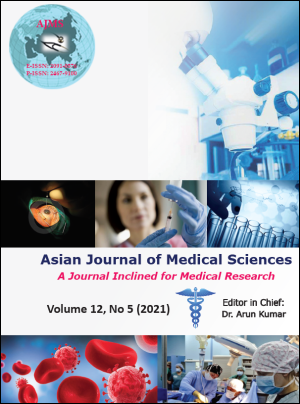Bacteriological profile and antimicrobial sensitivity pattern of isolates from diabetic foot of patients attending a teaching hospital in Northern India
Keywords:
Diabetic foot, Diabetic foot ulcer, Diabetic foot infection, Wagner’s gradingAbstract
Background: Diabetic foot ulcer is a major cause for diabetes related morbidity and hospitalization. Up to one-third of people with diabetes develop diabetic foot ulceration (DFU) during their lifetime and over 50% of these ulcerations become infected. Diabetic foot infections (DFIs) are associated with major morbidity, increasing mortality, high costs, increased risk of lower extremity amputation (LEA), and reduced quality of life.
Aims and Objective: The current study was conducted to determine the microbiological profile and antibiotic susceptibility pattern of organisms in diabetic foot ulcers patients at a tertiary care center in Srinagar province.
Material and Methods: This was a Cross-sectional, observational study conducted in diabetic patients with diabetic foot infection, randomly selected from outpatient departments (OPDs) and wards of Surgery and Medicine department, with Wagner grade 1-5 ulcers and irrespective of anti-diabetic treatment and diabetic foot injury treatment. Samples were processed and bacterial isolates were identified by standard microbiological procedures.
Results: After following inclusion and exclusion criteria, 120 patients were considered for this study. In present study most common age group was 51-60 years age group (44%) followed by 41-50 years (32%). 66% of participants were males. 55% patients had diabetes for more than 10 years. 43% patients had ulcer size less than 5 cm2. The most common category as per Wagner’s classification was Grade 1, which comprised of 48% of study participants, followed by Grade 0 (28%) and Grade 2 (18%). Grade 3 and above comprised 7% of cases. Of the 120 study participants, 103 (86%) showed growth on culture. Among these 62 (60%) showed mono-microbial growth with 41 cases showing mixed growth. The most commonly isolated bacteria were Methicillin Resistant Staphylococcus aureus (MRSA) (23%), Coagulase Negative Staphylococci (CoNS) (18%), pseudomonas aeruginosa (18%), Methicillin Sensitive-Staphylococci Aureus (9%), Klebsiella Pneumoniae (9%), and Escherichia Coli (8%). Linezolid, vancomycin, clindamycin, gentamicin were most effective antimicrobial agents against gram positive bacteria. Iimipenem, piperacillin tazobactam, cefoperazone sulbactam & gentamicin were most effective antimicrobial agents against gram negative bacteria.
Conclusion: Early microbiological evaluation for bacteriological profile, the nature of the infection either monomicrobial or polymicrobial and antibiotic sensitivity testing can improve treatmentoutcome, reduces complications, morbidity as well as multidrug resistance.
Downloads
Downloads
Published
How to Cite
Issue
Section
License
Authors who publish with this journal agree to the following terms:
- The journal holds copyright and publishes the work under a Creative Commons CC-BY-NC license that permits use, distribution and reprduction in any medium, provided the original work is properly cited and is not used for commercial purposes. The journal should be recognised as the original publisher of this work.
- Authors are able to enter into separate, additional contractual arrangements for the non-exclusive distribution of the journal's published version of the work (e.g., post it to an institutional repository or publish it in a book), with an acknowledgement of its initial publication in this journal.
- Authors are permitted and encouraged to post their work online (e.g., in institutional repositories or on their website) prior to and during the submission process, as it can lead to productive exchanges, as well as earlier and greater citation of published work (See The Effect of Open Access).




